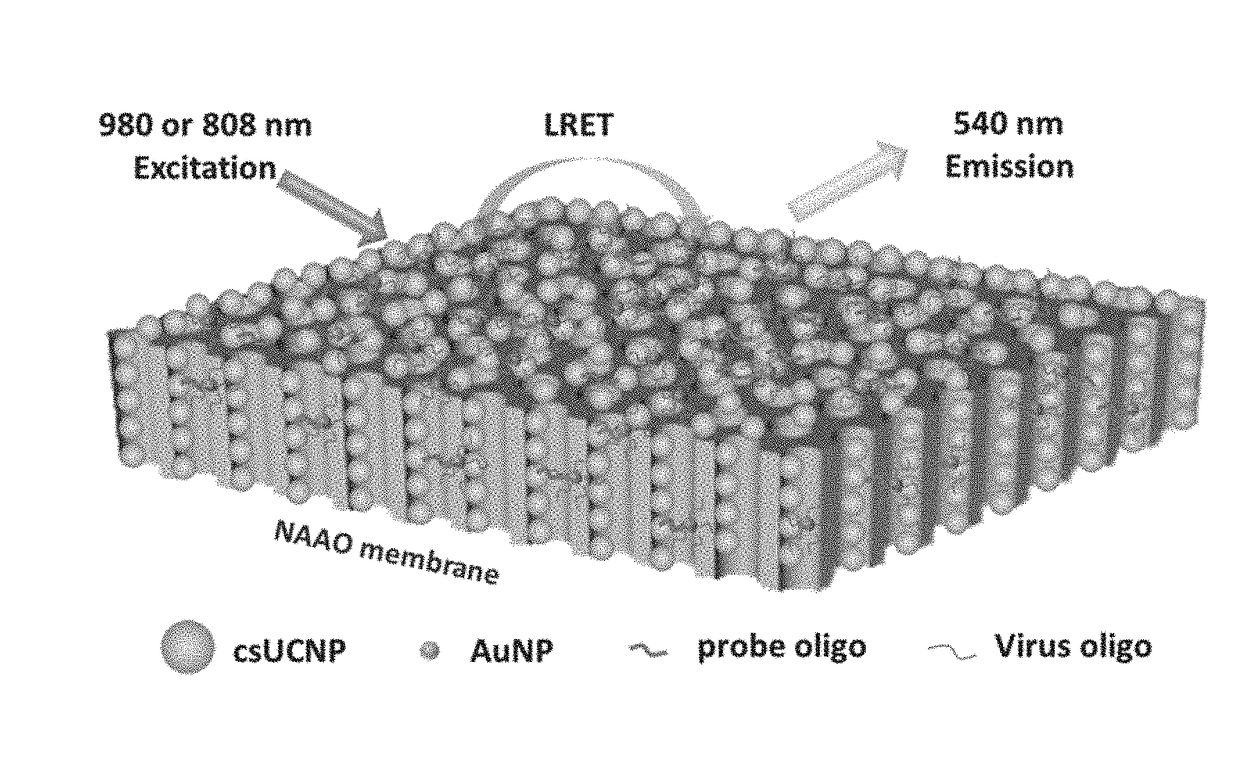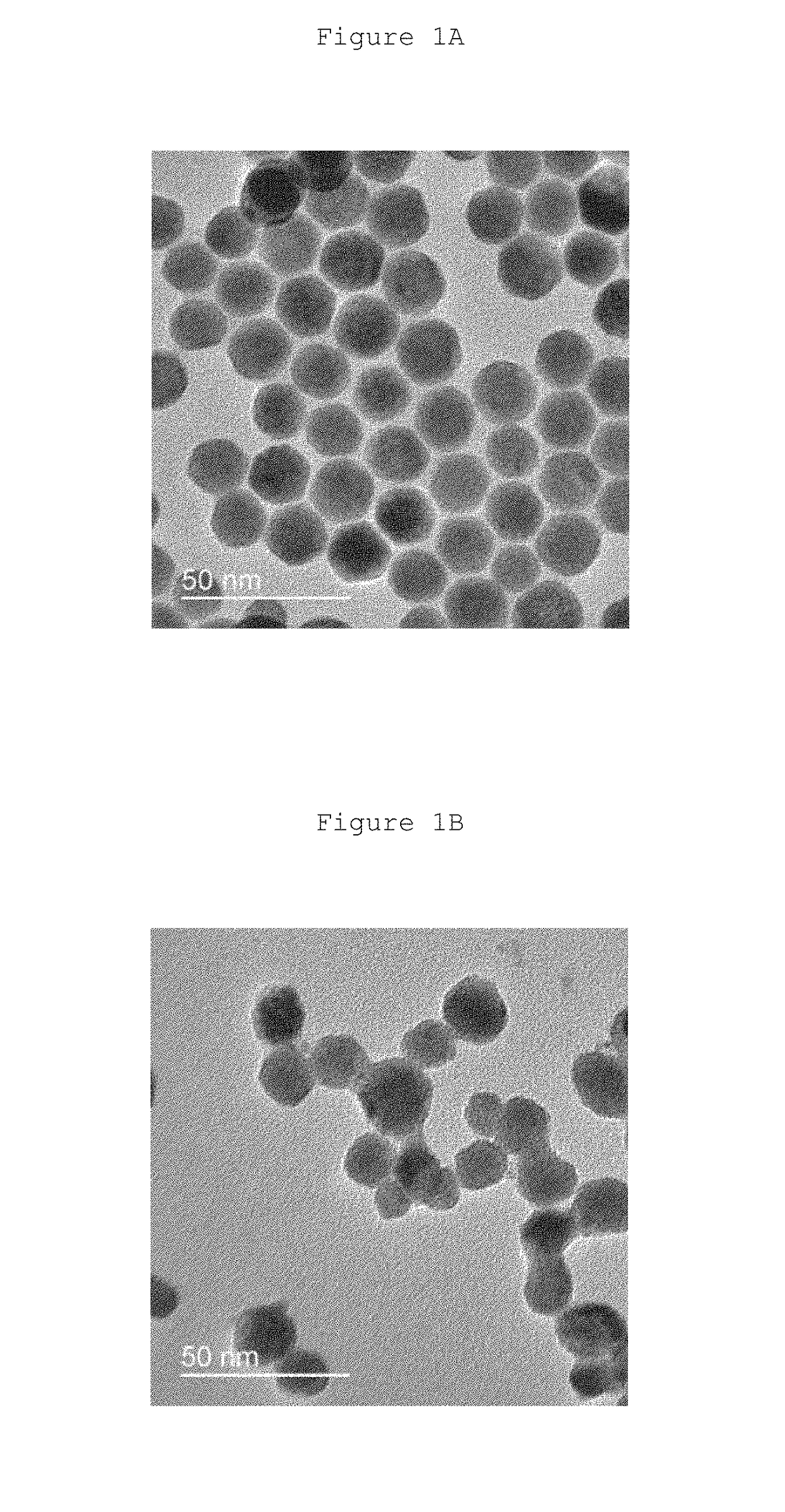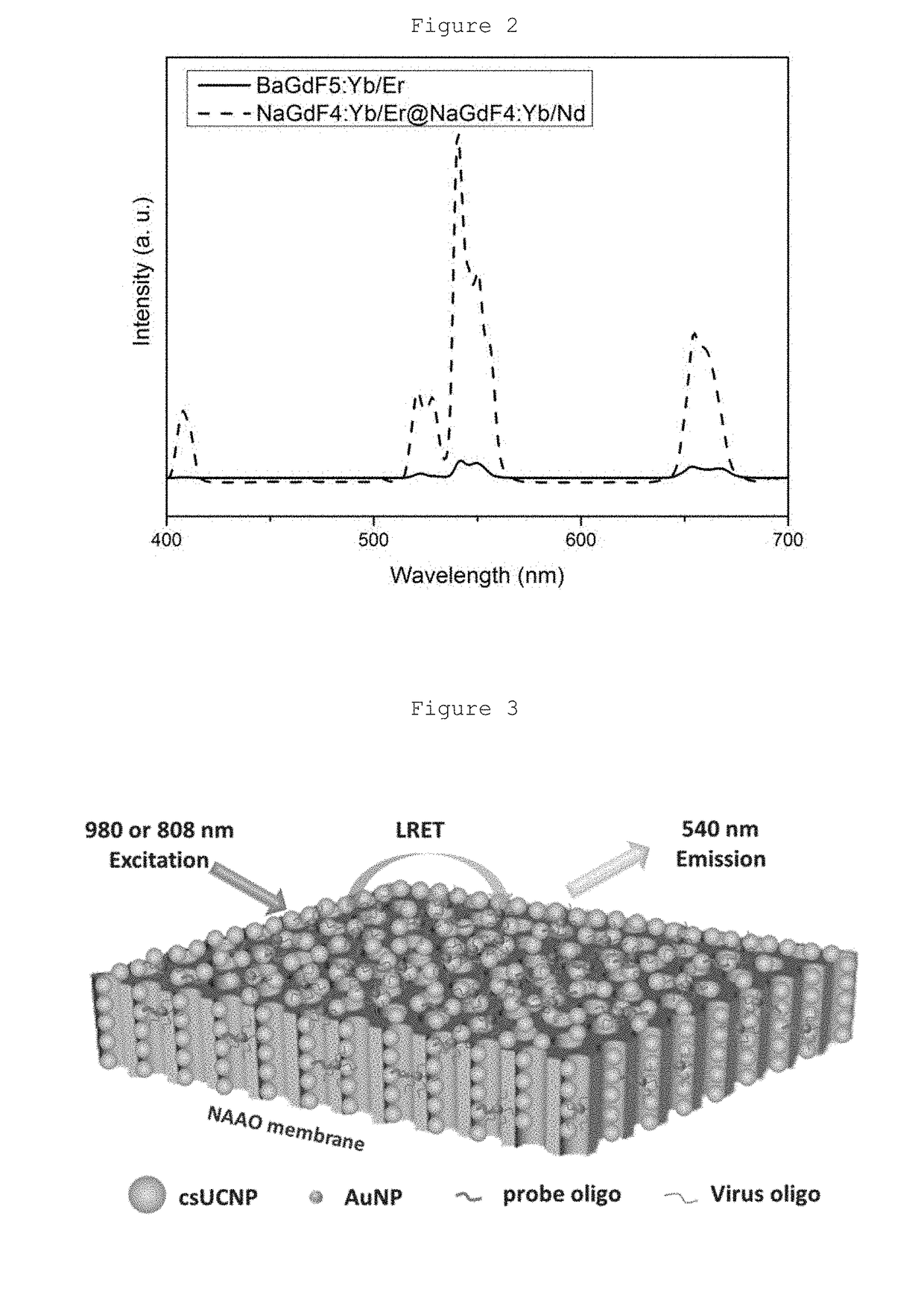Heterogeneous microarray based hybrid upconversion nanoprobe/nanoporous membrane system
a nanoprobe and nanoporous membrane technology, applied in the field of heterogeneous microarray based hybrid upconversion nanoprobe/nanoporous membrane system, can solve the problems of laborious elisa procedure procedures, prone to contamination of amplification steps, and relatively time-consuming amplification process
- Summary
- Abstract
- Description
- Claims
- Application Information
AI Technical Summary
Benefits of technology
Problems solved by technology
Method used
Image
Examples
example 1
Synthesis and Characterization of csUCNPs NaGdF4:Yb / Er@NaGdF4:Yb / Nd
[0044]The synthesis of the csUCNPs NaGdF4:Yb / Er@NaGdF4:Yb / Nd involved the synthesis of core and subsequent coating of the shell layer.
1. Synthesis of Core UCNPs
[0045]0.4 mmol of lanthanide (Ln) acetates consisting of gadolinium, ytterbium and erbium (78 mol %, Gd, 20 mol % Yb and 2 mol % Er) were added to a three-necked flask. Then, 4 ml of oleic acid (OA) and 6 ml of 1-octadecene (1-ODE) were injected into the same flask. The mixture was mixed vigorously and heat to 100° C. for 30 min. After that, the temperature was increased to 150° C. for 1 h. After the mixture was cooled to room temperature, 1 mmol sodium hydroxide and 1.2 mmol ammonium fluoride in methanol were added to the flask. Then, the mixture was heated to 50° C. for 30 min until no bubbles were observed. The temperature was increased to 100° C. and degassed for 10 min. The medium was then protected by argon gas and heated to 290° C. for 1.5 h. After cool...
example 2
Fabrication of the Microarray Based on Upconversion Nanoparticle / Nanoporous Anodized Alumina Membrane
1. Amine Functionalization of Nanoporous Anodized Alumina Membrane
[0052]The nanoporous anodized alumina (NAAO) membrane is boiled in a solution consisting of hydrogen peroxide (H2O2) and 3-Triethoxysilylpropylamine (APTES) for 10 min. Then, the NAAO membrane is washed with acetone and dried at 100° C. for 10 min. The process is repeated for three times.
2. Fabrication of Microarray by Covalent Coupling Reaction of PAA-csUCNPs and NH2-NAAO Membrane
[0053]A Polydimethylsiloxane (PDMS) thin film with nine wells is used as template for coupling reactions. The dimension of each well is 2 mm and the distance between consecutive wells is also 2 min. Before injection into the wells, the PAA-csUCNPs are activated. A mixture of 2 mg PAA-csUCNPs, 2 mg 1-ethyl-3-(-3-dimethylaminopropyl) carbodiimide hydrochloride (EDC·HCl) and 3 mg N-hydroxysuccinimide (NHS) in 0.1 M 4-Morpholineethanesulfonic (ME...
example 3
Simultaneous Detection of Multiple Viruses
1. Conjugation of Probe Sequence and the PAA-csUCNPs / NAAO Membrane
[0054]The NH2-functionalized probe oligonucleotide (oligo) sequence is purchased from Integrated DNA Technologies. The probe sequence is first activated via the previously mentioned covalent coupling reaction in step 2 of Example 2: 2 mg of EDC-HCl and 3 mg NHS are added to 500 μL MES buffer solution (pH 3.4). 2 nmol of the activated probe sequence is added to the membrane for conjugation with PAA-csUCNPs for 2 h. Then, the membrane is washed by DI water.
2. Capturing of Virus Oligonucleotide by Gold Nanoparticles
[0055]The 10 nm citrate-capped gold nanoparticles (AuNPs) is purchased from Sigma-Aldrich. The AuNPs are modified with MUA by mixing 5.44×1043 mol AuNPs and 1×10−6 mol MUA in DI water for 2 h. The thiol-modified AuNPs (MUA-AuNPs) are collected by centrifugation and redisperse in phosphate buffer. Then, 3 mM EDC in water was added to the MUA-AuNPs in PB buffer and shake...
PUM
| Property | Measurement | Unit |
|---|---|---|
| particle size | aaaaa | aaaaa |
| size | aaaaa | aaaaa |
| wavelength | aaaaa | aaaaa |
Abstract
Description
Claims
Application Information
 Login to View More
Login to View More - R&D
- Intellectual Property
- Life Sciences
- Materials
- Tech Scout
- Unparalleled Data Quality
- Higher Quality Content
- 60% Fewer Hallucinations
Browse by: Latest US Patents, China's latest patents, Technical Efficacy Thesaurus, Application Domain, Technology Topic, Popular Technical Reports.
© 2025 PatSnap. All rights reserved.Legal|Privacy policy|Modern Slavery Act Transparency Statement|Sitemap|About US| Contact US: help@patsnap.com



